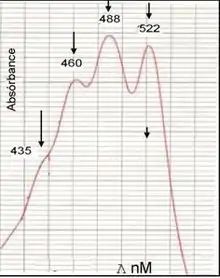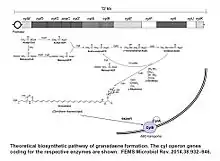Granadaene
Granadaene is the trivial name of a non-isoprenoid polyene that constitutes the red pigment characteristic of Streptococcus agalactiae (group B streptococcus).
 | |
| Names | |
|---|---|
| IUPAC name
(2S)-5-Amino-2-[[(2E,4E,6E,8E,10E,12E,14E,16E,18E,20E,22E,24E)-27-[(2R,3R,4R,5R,6S)-3,4,5-trihydroxy-6-methyloxan-2-yl]oxyoctacosa-2,4,6,8,10,12,14,16,18,20,22,24-dodecaenoyl]amino]pentanoic acid | |
| Identifiers | |
3D model (JSmol) |
|
PubChem CID |
|
| |
| |
| Properties | |
| C39H52N2O8 | |
| Molar mass | 676.851 g·mol−1 |
Except where otherwise noted, data are given for materials in their standard state (at 25 °C [77 °F], 100 kPa). | |
| Infobox references | |
Characteristics
Granadaene contains a conjugated system made up of a linear chain of 12 conjugated double bonds which is connected to the amino acid ornithine at one end and the sugar rhamnose at the other.[1][2] Granadaene is dark red, odorless, insoluble in water, methanol, ethanol, diethyl ether, acetone, hexane, dimethyl sulfoxide (DMSO), acetonitrile, tetrahydrofuran, chloroform, and in most solvents, it is soluble in DMSO–0.1% trifluoroacetic acid (TFA).[1] Granadaene, can be extracted from cultures of S.agalactiae in granada broth (granada medium without agar) with 0.1 M potassium hydroxide (KOH) and purified by size-exclusion chromatography on Sephadex LH using DMSO–0.1%TFA.[1]




The ultraviolet-visible absorption spectrum of the granadaene (in DMSO/TFA) is almost identical to that of a carotene with a similar conjugated system of double bonds (e.g. alpha-carotene), that is why the GBS pigment was considered to be a carotene for many years.[3]
Granadaene and S.agalactiae detection and identification
Production of the red pigment granadaene is a phenotypic trait specific to β-hemolytic GBS, and because of that, detection of red colonies from clinical samples, when cultivated on granada medium, allows the straightforward identification of GBS.[4][5][6]
Biological relevance
Granadaene is an organic compound produced by S.agalactiae. It is the product of a metabolic pathway similar to that of biosynthesis of fatty acids. The enzymes necessary for the biosynthesis of granadaene in GBS are coded by a gene cluster of 12 genes, the cyl operon, and a pathway for the pigment biosynthesis requiring all the genes of the cyl operon has been proposed.[7][8] Like the biosynthesis of the pigment, the hemolytic activity requires also in GBS the 12 genes of the cyl operon.[9][10] The pigment is localized, in GBS, in the cell membrane,[3] where it could play a role in membrane stabilization, similarly to the role of carotenes in other bacterial membranes.[11] It has also been proposed that granadaene is indeed the hemolysin of S.agalactiae, and because the GBS hemolysin is a broad-spectrum cytolysin able to destroy many eukaryotic cells, it is considered an important virulence factor for GBS.[7][8][12][13][14]
In addition to S.agalactiae the presence of granadaene and the cyl genes has been reported in pigmented Acidipropionibacterium spp. (former Propionibacterium) as A.jensenii, A.thoenii and A.virtanenii , where it can cause defects such as red spots in some cheeses.[15] Probably granadaene is also present in other related species such as Pseudopropionibacterium rubrum.[8][15][16]
The cyl genes has been cloned in Lactococcus lactis (a non-hemolytic non-pigmented Gram-positive bacterium) and the expression of the GBS cyl operon conferred hemolysis, pigmentation, and cytoxicity to Lactococcus lactis. Proving that the expression of the genes of the cyl operon is sufficient for Granadaene production in a heterologous host.[17]
References
- Rosa-Fraile M, Rodríguez-Granger J, Haidour-Benamin A, Cuerva JM, Sampedro A (2006). "Granadaene: Proposed Structure of the Group B Streptococcus Polyenic Pigment". Appl Environ Microbiol. 72 (9): 6367–6370. doi:10.1128/aem.00756-06. PMC 1563658. PMID 16957264.
- Paradas M, Jurado R, Haidour A, Rodríguez Granger J, Sampedro Martínez A, de la Rosa Fraile M, Robles R, Justicia J, Cuerva JM (2012). "Clarifying the structure of granadaene: Total synthesis of related analogue - granadaene and confirmation of its absolute stereochemistry". Bioorg Med Chem. 20 (22): 6655–6661. doi:10.1016/j.bmc.2012.09.017. PMID 23043725.
- Merrit K, Jacobs NJ (1978). "Characterization and Incidence of Pigment Production by Human Clinical Group B Streptococci". J Clin Microbiol. 8 (1): 105–107. PMC 275130. PMID 353069.
- Rosa-Fraile M, Rodriguez-Granger J, Cueto-Lopez M, Sampedro A, Biel Gaye E, Haro M, Andreu A (1999). "Use of Granada Medium To Detect Group B Streptococcal Colonization in Pregnant Women" (PDF). J Clin Microbiol. 37 (8): 2674–2677. doi:10.1128/JCM.37.8.2674-2677.1999. PMC 85311. PMID 10405420. S2CID 22347982.
- Verani JR, McGee L, Schrag SJ (2010). "Prevention of perinatal group B streptococcal disease: revised guidelines from CDC, 2010" (PDF). MMWR Recomm Rep. 59(RR-10): 1–32.
- Filkins L, Hauser J, Robinson-Dunn B, Tibbetts R, Boyanton B, Revell P. "Guidelines for the Detection and Identification of Group B Streptococcus 2020. American Society for Microbiology" (PDF). ASM. Retrieved 9 December 2020.CS1 maint: multiple names: authors list (link)
- Whidbey C, Harrell MI, Burnside K, Ngo L, Becraft AK, Iyer LM, Aravind L, Hitti J, Waldorf KM, Rajagopal L (2013). "A hemolytic pigment of Group B Streptococcus allows bacterial penetration of human placenta". J Exp Med. 210 (6): 1265–1281. doi:10.1084/jem.20122753. PMC 3674703. PMID 23712433.
- Rosa-Fraile M, Dramsi S, Spellerberg B (2014). "Group B streptococcal haemolysin and pigment, a tale of twins" (PDF). FEMS Microbiol. Rev. 38 (5): 932–946. doi:10.1111/1574-6976.12071. PMC 4315905. PMID 24617549.
- Spellerberg B, Pohl B, Haase G, Martin S, Weber-Heynemann J, Lütticken R (1999). "Identification of genetic determinants for the hemolytic activity of Streptococcus agalactiae by ISS1 transposition". J. Bacteriol. 181 (10): 3212–3219. doi:10.1128/JB.181.10.3212-3219.1999. PMC 93778. PMID 10322024.
- Spellerberg B, Martin S, Brandt C, Lütticken R (2000). "The cyl genes of Streptococcus agalactiae are involved in the production of pigment". FEMS Microbiol. Lett. 188 (2): 125–128. doi:10.1111/j.1574-6968.2000.tb09182.x. PMID 10913694.
- Taylor RF. (1984). "Bacterial triterpenoids". Microbiol. Rev. 48 (3): 181–198. doi:10.1128/MMBR.48.3.181-198.1984. PMC 373008. PMID 6387426.
- Whidbey C, Vornhagen J, Gendrin C, Boldenow E, Samson JM, Doering K, Ngo L, Ezekwe EA Jr, Gundlach JH, Elovitz MA, Liggitt D, Duncan JA, Adams Waldorf KM, Rajagopal L (2015). "A streptococcal lipid toxin induces membrane permeabilization and pyroptosis leading to fetal injury". EMBO Mol. Med. 7 (4): 488–505. doi:10.15252/emmm.201404883. PMC 4403049. PMID 25750210.
- Armistead B, Oler E, Adams Waldorf K, Rajagopal L. (2019). "The Double Life of Group B Streptococcus: Asymptomatic Colonizer and Potent Pathogen". J Mol Biol. 431 (16): 2914–2931. doi:10.1016/j.jmb.2019.01.035. PMC 6646060. PMID 30711542.CS1 maint: multiple names: authors list (link)
- Armistead B, Herrero-Foncubierta P, Coleman M, Quach P, Whidbey C, Justicia J, Tapia R, Casares R, Millán A, Haidour A, Granger JR, Vornhagen J, Santana-Ufret V, Merillat S, Adams Waldorf K, Cuerva JM, Rajagopal L. (2020). "Lipid analogs reveal features critical for hemolysis and diminish granadaene mediated Group B Streptococcus infection". Nat. Commun. 11 (1): 1502. Bibcode:2020NatCo..11.1502A. doi:10.1038/s41467-020-15282-0. PMC 7083881. PMID 32198389.CS1 maint: multiple names: authors list (link)
- Vanberg C, Lutnaes BF, Langsrud T, Nees IF, Holo H (2007). "Propionibacterium jensenii produces the polyene pigment granadaene and has hemolytic properties similar to those of Streptococcus agalactiae". Appl Environ Microbiol. 73 (17): 5501–5506. doi:10.1128/AEM.00545-07. PMC 2042088. PMID 17630313.
- Saito M, Shinozaki-Kuwahara N, Tsudukibashi O, Hashizume-Takizawa T, Kobayashi R, Kurita-Ochiai T. (2018). "Pseudopropionibacterium rubrum sp. nov., a novel red-pigmented species isolated from human gingival sulcus". Microbiol Immunol. 62 (6): 388–394. doi:10.1111/1348-0421.12592. PMID 29687917. S2CID 22322865.CS1 maint: multiple names: authors list (link)
- Armistead B, Whidbey C, Iyer LM, Herrero-Foncubierta P, Quach P, Haidour A, Aravind L, Cuerva JM, Jaspan HB, Rajagopal L. (2020). "The cyl Genes Reveal the Biosynthetic and Evolutionary Origins of the Group B Streptococcus Hemolytic Lipid, Granadaene". Front. Microbiol. 10: 3123. doi:10.3389/fmicb.2019.03123. PMC 6985545. PMID 32038561.CS1 maint: multiple names: authors list (link)